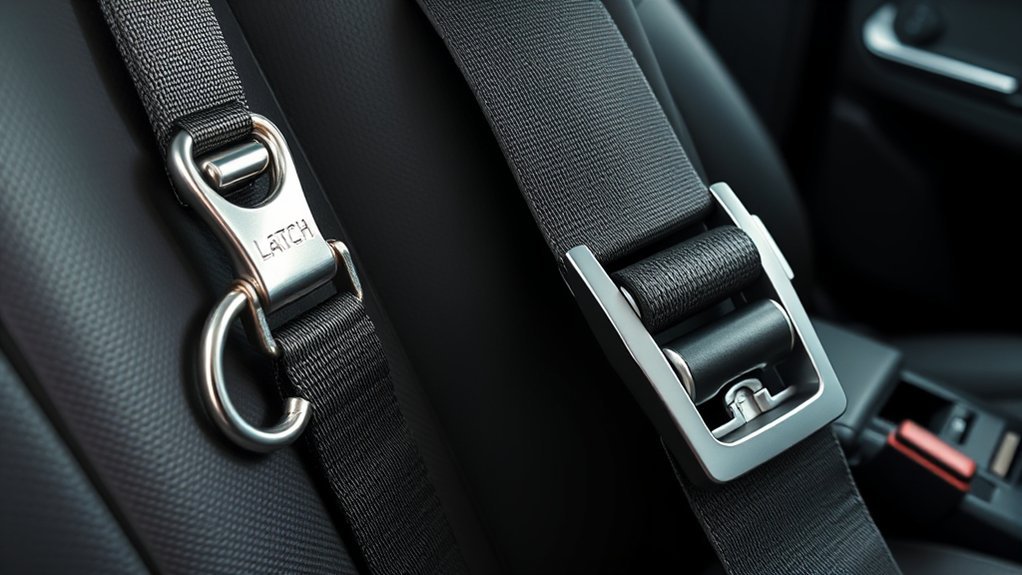When it comes to securing your child’s safety seat, the decision between LATCH and seatbelt can feel like traversing a maze. Each method has its own set of advantages and considerations that can greatly impact installation and safety. Understanding these nuances is essential for ensuring your child’s protection in the vehicle. So, which option should you choose, and when? Let’s explore the key points that will help clarify your decision.
What Is the LATCH System?
The LATCH system, which stands for Lower Anchors and Tethers for Children, is a standardized method designed to simplify the installation of child safety seats in vehicles.
The LATCH system simplifies child safety seat installation with standardized lower anchors and tethers for enhanced security.
It provides two lower anchor points in your vehicle’s seat and a top tether to secure the car seat effectively. Using LATCH can make installation quicker and more secure, helping to reduce the risk of improper fitting.
To use the LATCH system, you’ll need to locate the anchor points in your car and attach the car seat’s connectors accordingly.
Always check your vehicle’s manual for specific instructions, as the LATCH system can vary by make and model.
Familiarizing yourself with this system guarantees that your child’s safety seat is installed correctly and securely.
How Does a Seatbelt Secure a Car Seat?
When securing a car seat with a seatbelt, you guarantee your child’s safety by following a straightforward process.
First, position the car seat in the back seat of your vehicle, confirming it’s level and stable.
Next, thread the seatbelt through the appropriate belt path on the car seat, which is usually marked for clarity.
Pull the seatbelt tight to eliminate any slack, and then buckle it securely.
After buckling, check that the car seat doesn’t move more than an inch side-to-side or front-to-back.
Finally, always double-check the seatbelt’s locking mechanism to verify it’s engaged properly.
What Are the Benefits of Using LATCH?
Using LATCH (Lower Anchors and Tethers for Children) offers several significant advantages for securing your child’s car seat.
First, it simplifies the installation process, eliminating the need to thread the seatbelt through the car seat. This convenience often leads to a more secure fit, reducing the risk of incorrect installation.
Additionally, LATCH systems are designed to accommodate various car seat types, guaranteeing compatibility with both rear-facing and forward-facing seats.
You’ll appreciate the built-in tethers that further stabilize the seat, providing extra protection during a crash.
LATCH also has clear indicators to help you verify the seat is properly attached, making it easier to check for security.
When Should I Use a Seatbelt Instead of LATCH?
Have you ever wondered when it’s better to secure your child’s car seat with a seatbelt rather than LATCH?
There are specific situations where using a seatbelt is the safer and more effective option.
Here are some key scenarios:
- Older Car Models: If your vehicle is older and doesn’t have LATCH anchors, a seatbelt is your go-to.
- Car Seat Weight Limits: When your child exceeds the weight limit for LATCH, switch to a seatbelt for added safety.
- Multiple Car Seats: If you’re installing multiple seats, seatbelts can sometimes provide a more secure fit.
- Tight Spaces: In cramped back seats, seatbelts may allow for easier installation than LATCH connectors.
Choosing the right method guarantees your child’s safety on the road.
Can I Use Both LATCH and Seatbelt Together?
While it might seem appealing to combine LATCH and a seatbelt for extra security, doing so isn’t recommended by safety experts.
Using both systems can create confusion and potentially lead to improper installation. LATCH is designed to anchor your car seat securely, and it meets safety standards on its own. When you use a seatbelt, it may interfere with the LATCH system’s ability to function correctly.
Using both LATCH and a seatbelt can cause confusion and compromise your car seat’s safety installation.
To guarantee your child’s safety, choose one method—either LATCH or the seatbelt.
Follow the manufacturer’s instructions carefully for whichever system you select. If you’re unsure, consult your car seat manual or a certified technician for guidance.
Always make sure your car seat is installed tightly, regardless of the method you use.
Frequently Asked Questions
Is LATCH Safer Than Using a Seatbelt?
Yes, using a LATCH system can be safer than a seatbelt, as it typically provides a more secure installation for car seats. However, proper installation and usage of either method is essential for maximum safety.
Can LATCH Be Used in All Vehicles?
No, LATCH can’t be used in all vehicles. It’s designed for those equipped with specific LATCH anchors. Always check your vehicle’s manual to verify compatibility before using LATCH for your child’s car seat installation.
What Is the Weight Limit for LATCH?
The weight limit for LATCH systems typically caps at 65 pounds, including the child and the seat. Always check your car seat’s manual and your vehicle’s specifications for exact guidelines to guarantee safety.
Are There Car Seats That Do Not Use LATCH?
Yes, there are car seats that don’t use LATCH. Many models rely solely on seatbelt installation. Always check the manufacturer’s guidelines to verify you’re using the correct method for safety and compliance.
How Do I Know if My Car Has LATCH Anchors?
Check your car’s manual or look for small anchors in the seat crevices, usually marked with a child seat symbol. You’ll typically find them in the back seat, often between the seat cushions.
Conclusion
In the dance of car seat safety, choosing between LATCH and seatbelt is essential for your child’s protection. Each method has its strengths, like two sides of a coin. LATCH offers simplicity, while seatbelts provide versatility in older vehicles. Remember, using one method at a time guarantees a secure fit, like a well-tailored suit. By following the manufacturer’s guidelines, you can navigate this important decision with confidence, making sure your little one travels safely wherever the road leads.
